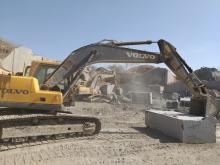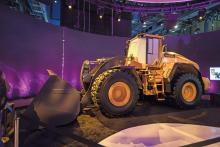Contractors Roth & Söhne based in Ellwangen, Germany, has expanded its excavator fleet with a
Designed primarily for heavy digging duties and handling bulk materials, New Holland says the E385C also provides powerful performance combined with low fuel consumption.
Before delivery by New Holland dealer Böhrer Baumaschinen, the excavator was equipped with a
“The E385 has a sturdy six-cylinder engine and an extremely sensitive and fast hydraulic system,” says Matthias Meiser, CEO of New Holland dealer Böhrer.
With an operating weight of around 38tonnes, the heavy crawler excavator’s common-rail engine, offering rated power of 213kW, has a new ECO working mode.
“This is very important when it comes to reducing customer costs in the long-term. The New Holland excavator also meets the specifications of the EU exhaust emissions standard stage 3B, with its integrated CEGR system,” says Meiser.
Thomas Roth, CEO of Roth & Söhne, is convinced the new machine will offer competitive advantages due to the combination of state-of-the-art excavator technology and precise 3D steering using GPS, together with previous positive experience Roth has had, using 3D steering systems for its excavators.
The machine was first used in a re-naturalisation project in Ellwangen, to restore a section of the natural course of a tributary of the River Jagst. As part of the landscaping project an area of 10,000m² had to be remodelled. With the GPS system, the pegging out of the area by a surveyor could be minimised, and for Roth & Söhne this meant substantial savings, not only on fuel but across the whole project. There was less shifted material, more precise positioning, as well as reduced costs for the building surveyor.
This was possible because most of the details of the planned works were available on the display in the cab, enabling the machine operator to check the position of the excavator and equipment to the exact millimetre.
With approximately 7,000m³ of material having to be moved, the new E385C with its 3D steering system offered smaller shortfall quantities and travelling motions, thus saving the company time, wages and machine costs.









